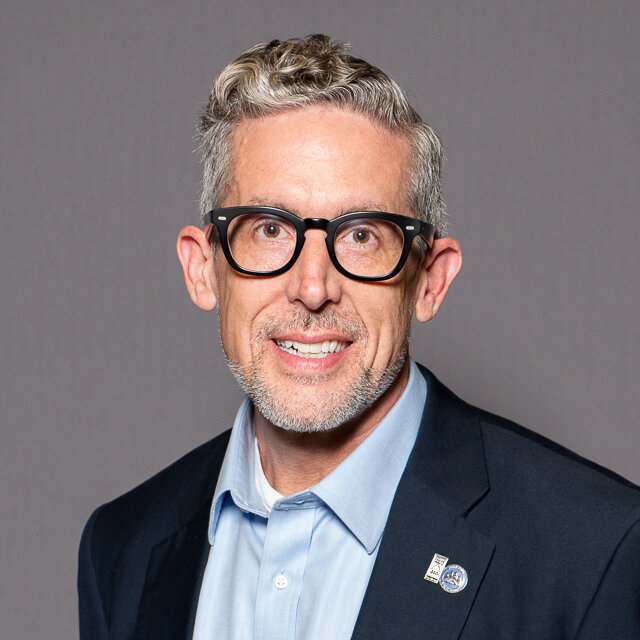Sean Kershaw - A Revolution and Evolution in Public Works
/It’s hard to imagine a more enthusiastic celebrant of snowplowing and street lights than Sean Kershaw. As Director of St. Paul’s Public Works, Sean flexes the job’s big muscles (bridge building and road construction) and finesses the fine motor skills (right-of-way permits and sidewalk poetry) required to keep the Capital City safe, connected, and interesting. Even the gig’s clothing requirements make him giddy, “I’m wearing Red Wing steel toed boots right now!” the Director effuses, “And I love fancy shoes!”
Sartorial opportunities aside, Sean seems to really dig the nitty-gritty of hardscape management, and not because he loves back hoes, or curb cuts, or calculating cubic feet of salt and sand per road mile, per se. “Well, I do have a map of the sewer running from my house,” he admits, “I AM fascinated about things underground.”
Example of a St. Paul sewer map, circa 2003
Sean is neither an engineer nor a long-time civil servant, two usual pathways into Public Works. What drew Sean to this job eight months ago was the mix Public Works provides between people, policy, and problem solving. “There is a human connection to pavement,” Sean asserts, “I always tell people that there are very few public agencies that touch citizens and businesses as directly - on a daily basis - as Public Works does.” He holds up his hand to count the amenities and services that he and his department oversee: “Garbage collection, sanitary sewers, water, recycling, snow removal, street signs, lighting, surveying, sidewalk repair, soil drainage, road construction, crosswalks, public spaces,” he says, smiling and dramatically running out of fingers.
And if there ever was a time when the connection between humans and their physical space were on display, it was 2020. With the pandemic raging, citizens took to the outdoors for fresh air; to “distance walk” with friends; to support children and pets working out their wiggles without damaging the furniture; and to escape the confines of basements, bedroom offices, and servitude to Zoom.
And then: the murder George Floyd on May 25. People all over St. Paul and the world took to the streets to protest, mourn, find solace and community, and to occupy the very public space in which Mr. Floyd took his last breath under the knee of a Minneapolis police officer. Sean takes a deep breath. “Public Works very much operates in this realm,” he says. “We are in the business of providing and maintaining spaces that must offer and guarantee inclusion, justice and ownership.” Then the Director quotes Melvin Carter, verbatim, from a note taped above his desk: “Mayor Carter says, ‘How do we create a public right of way that conveys the needs and hopes of the public?’”
Protesters take to the streets in St. Paul following the murder of George Floyd, summer 2020 photo: WBAL 11
Recognizing the overlap between the basic physical needs of citizens and broader opportunities for community safety, human healing, and connection, Sean was eager to earn the job as Director of Public Works under Mayor Carter because he thinks he can offer both adaptive change and technical solutions. It is a new era. “Care of the Public Realm is going through a revolution everywhere,” he notes. “We have crumbling infrastructure all over this country, decades of deferred maintenance, and we carry the scourge of large public projects that resulted in displacement and very real racial injustices.”
One example of racial injustice comes easily to Sean’s mind. St. Paul’s Rondo neighborhood was devastated when Interstate 94 sliced through it in the late 1950’s and early 1960’s. Rondo contained half of St. Paul’s black population at the time, and the project razed an estimated 600 homes and 300 businesses owned by black citizens. The City’s decision-makers excluded the people most affected by the project’s path, and the tight-knit, middle-class black community was dispersed.
The historic trauma of that intentional erasure remains. Sean, who is white, knows St. Paul failed its black citizens then and that he is on the hook to do better now. “We have a better understanding of the problems now,” he says. “Not only has the US not invested in infrastructure, we know we have invested inequitably. This isn’t radical or partisan,” he adds, “how we spend money is important.”
Interior of the Credjafawn Co-op Store, 678 Rondo Avenue, St. Paul, ca. 1950 Photo: MNopedia
Sean supposes Mayor Carter chose him to lead Public Works because of his nearly 15-year tenure running the non-profit, non-partisan Citizen’s League (from 2003-2017) in St. Paul, work that Mayor Carter appreciates. The Citizen’s League’s mission “empowers people to engage in civic life and public policy to make Minnesota a better place to live and work for everyone.” Sean says The Citizen’s League taught him stakeholder engagement, about broad inclusion in community conversations, unintended consequences, and the necessity of tangible, practical fixes that people can see and touch. Those lessons guide him: “First, people impacted by a problem MUST be involved in the solutions. If we are trying to improve ‘Safety,’ we must ask, ‘What does safety mean to you?’ ‘What matters most?’ and, ‘Would you choose this fix, or that?’”
This process of including more perspectives can be messy and more time-consuming, but Sean believes that a “better definition of a problem leads to better solutions.” He extends that understanding across the ecosystem of Public Works’ responsibilities, seeking greater diversity in engagement, hiring, and partners, and even in decorative elements in the built-environment that nod to St. Paul’s many cultural identities. A current project, a bridge from Lowertown to Kellogg Boulevard, spans a Wacan Tipi site (Wakan Tipi means “Dwelling Place of the Sacred” in Dakota). The City is working with the Dakota community to design the bridge piers and ornamentation on the bridge span that will celebrate traditional Indigenous themes and the Dakota community that resides here still.
Finally, racial equity is at the stated heart of city operations under Mayor Carter and Director Kershaw, and other paradigm shifts are happening, too. Technology is rapidly offering exciting opportunities, data is driving more decisions, and citizens expect leaders to make hard choices to tackle climate change. An evolution, as much as a revolution, is occurring in St. Paul. “Most people recognize that we will continue to have cars,” Sean offers as an example, “and they know we need to change our ways, putting pedestrians at the top of our transportation priority list and cars at the bottom. In between, we make space for buses, autonomous cars, and bicycles.” And potholes! Public Works still needs to be vigilant about fixing those potholes, because, as Sean asserts, “what’s bad for bicyclists is bad for drivers, too!”
Sean pledges to be more mindful of a changing population and changing expectations in St. Paul. “We have a system built on a model you and I grew up on, and that system was built for a different time. Our citizens are more vocal, able to engage in person and on line, and the population is aging: we will have more elderly people going forward and they, too, need more options to get around, to feel safe. We need to balance both long-term infrastructure needs with what matters to people now.”
Resources:
St. Paul Public Works Department: https://www.stpaul.gov/departments/public-works
Rondo Neighborhood: https://www.startribune.com/why-did-i-94-get-built-right-through-the-middle-of-st-pauls-rondo-neighborhood/600001544/
Photos courtesy of: St. Paul Public Works, MNopedia, WBAL 11

















